Space and Architecture
An Unconventional relationship…
Prof. Jaffer AA Khan
|
Architecture as a subject has continuously witnessed a rapid change in terms of approach in the last few decades. Globally, it has evolved as a multi-disciplinary subject conveying different messages to different cultures through its design and has transformed the urban milieu in many ways. In architecture, ‘Space’ is a common factor which plays an important role in the context of designing. A few architects look at it as a creative form and others portray it as a connection between the human form and structure. But, for Prof. Ar. Jaffer AA Khan, who staunchly believes in Vedas says, “Space is that which accommodates space”. He equates space with human brain.
Built Expressions exclusively spoke to Mr. Khan to explore more on the unusual connection between space and architecture.Ar. Khan graduated from University of Madras with Gold Medal in Architecture. Later, he went to finish his Master’s in London from the Bartlett School of Architecture and Planning UC, University of London.
|
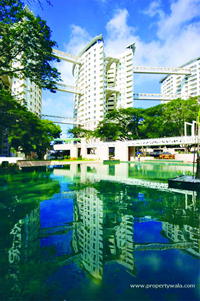 |
In 1984, he was bestowed with several awards including Shri. Jawaharlal Nehru Memorial Award, the Aga Khan International Scholarship, Geneva and Sir Herbert Henry Bartlett Scholarship in 1985 by the University of London. His projects are widely published and nominated to The Aga Khan Award during 1995 cycle (Erode Mosque-Periagraharam Erode-MIT Digital Archives).
| Ar. Khan wears several caps. He initiated Jaff Design Studio (JDS) at Vellore in 1985 and later the firm was shifted to Bangalore in 1990. At present, he maintains studios both in Bangalore and Chennai. In 2011, Ar. Khan along with Mr. GRK Reddy founded MARG Institute of Design and Architecture Swarnabhoomi (MIDAS) in Tamilnadu, a unique institution for architecture education which focuses on industry led academia. At present, Ar. Khan is serving as a Director at MIDAS. |
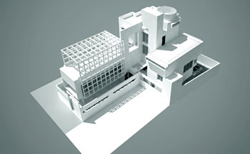 |
He is associated with many esteemed professional associations like Royal Institute of British Architects (RIBA), Royal Australian Institute of Architects (RAIA), Singapore Institute of Architects (SIA) and Indian Institute of Architects (IIA).
JDS Catering to Various Segments
JDS caters to segments like commercial, institutional, religious, residential and industrial. But Ar. Khan has a special interest towards heritage conservation as well. In terms of heritage conservation, he has been personally involved with INTACH for a long time. During his college days, he had a deep interest in conservation, so he documented Vellore fort in 1980, in 1982 – documented the Lower Fort in Gingee for which Ar. Khan received Louis Kahn award and in 1984 - documented 1806 Mutiny of Vellore & listing of tombs in central cemetery. Further to this, he also documented heritage buildings in and around Vellore district and conducted an exhibition called the ‘Heritage Exhibition’ for the citizens of Vellore. The main aim of the exhibition was to throw a light on the history of Vellore town. These heritage sites especially Jalakandeshwara temple of Vellore Fort was a great inspiration for Ar. Khan to took up architecture as his main study course.
He says, “Besides these sectors, at present, the segment which is in great demand is the residential segment. This segment has become an investment for the people with the mass housing coming up in terms of apartments. So, this will continue for next two to three decades.”
| Integrating Nature and Space Ar. Khan is specialised in Environmental Design. In this, he dealt with temporal environment, oral environment, visual environment and psychology of space. So, when asked about integrating nature and space in the buildings, he says, “Architecture is very subjective. Here, unless an architect gets into the minds of an occupant, he cannot produce good architecture. ut in a large project, you cannot get into |

|
the minds of all 1000 occupants. If it is an individual client, then an architect can play an important role.In mass projects, the important factor is that the architects have to deal with environment and have to see the impact of the project on the society."According to Ar. Khan, architecture should complement the environment rather than contradicting it. So, the contribution of an architect towards nature through his designs becomes very important. He illustrated this with an example of one of their projects in Bangalore. He says, “We realised ETA Gardens, a residential project in 2005 which has about 1000 apartment. It is about 16 acres and had about 588 trees. When we were employed as architects, the first thing we did was the tree mapping. With the guidance of horticulturist, we categorised the trees based on their age. We found out about 30 to 40 trees needed elimination. But ultimately, we eliminated less than 15 to 20 trees.”
Sharing a small anecdote during the construction of project Ar. Khan says, “In ETA project, there was a huge tree. The horticulturist said that the tree will not last long and will die in about 5 years of time. But, when the project was completed, that old tree survived and that tree is still there today. The tree has flourished so well and has been giving shade to the residents. If we walk ten feet towards nature then, the nature comes running one hundred feet towards us. This means the more we go closer they come closer to us. Here, architecture becomes a living organism.”
Role of Five Elements of Nature in Architecture
According to Ar. Khan, all the five elements of nature water, fire, air, earth and space play an important role in human being. He explains, “A human body is composed of water, fire (right temperature), air (to breath), earth (body as a matter) and I equate space with brain. Brain has got tremendous amount of space and can store entire database of your life. Your instincts are mapped within you. In my view, ‘Space is that which accommodates space’ and that space is very difficult to explain.” In the microcosm, brain is the space and that has enormous amount of capacity to absorb, reflect and react. But, how does this relate to architecture? He elucidates further, “All these elements water, fire, earth, air are simple terms that we could understand. But, when it comes to space, according to Hindu philosophy ‘Space is like to ether’. It is very difficult to visualise space in three dimensions. I think it takes time for you to realise what it means to you. Sometimes rich intellectual wisdom helps you to try and understand what it really means. Space has a different meaning in different cultures. Here, architecture is a built microcosm. The Microcosm talks about all the five elements and responds in a suitable manner.
Sustainability in Architecture
| Ar. Khan feels that ‘Sustainability’ is a very strange concept. He says, “If we can construct buildings that will have the least dependence on the fossil fuels, for me that is sustainability. At present, we are dependent on these fossil fuels and they are producing energy for us. But, one day, we will see a man producing the energy for another type of creature who would be living a few billion years from now. We know the fact that 50 percent of the energy is consumed by the construction industry. As long as, we realise that there are alternatives available for the usage of energy, we cannot save our Mother Earth.”He adds, “We can reverse the process but for that, we need people’s will,politicians support and the determination by the professionals like architects and developers.In my view, |
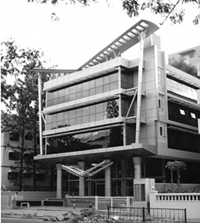 |
sustainability has to be redefined in many ways but at the same time, it has to be closely discussed with the stakeholders.”
Development in the Urbanised Sector
With the increase in urbanisation, the cities are rapidly growing with its size and population. When asked Ar. Khan how sustainability can be achieved in such scenario, he says, “The growth in cities is inevitable and urbanisation is a global problem and especially, it is a problem of growing economies. There is no immediate solution for this. We as citizens, have a great responsibility to build this nation. With the kind of intellectual resources India has, I think in 50 years time, it will have one of the finest resources in the world. India has the right population, if we give them the right education that will have a great impact on the future generation.”
Further he says, “If I run a School of Architecture, I need to be responsible in what knowledge, I am passing on to my students. If I am successful in changing the perception of one generation of students, definitely it will have a chain reaction. Producing architecture is like creating a human form. Every bit of architecture is an important factor and it will contribute to the environment around. It will surely change the entire idea of architecture.”
PURA can Trigger Rural Development
Ar. Khan explained the concept of Urbanisation with the programme initiated by the former President APJ Abdul Kalam. Mr. Kalam instigated Provision of Urban Amenities in Rural Areas (PURA), a programme which basically acts as magnets to provide rural people with all facilities like economic, education, socio and cultural facilities within the limits of the rural areas. It is a very interesting concept. But, how far this has been implemented is questionable.
“By 2050, it is assumed that all major metropolitan cities like Delhi, Mumbai, Kolkata, Chennai, and Bangalore will have rapid increase in population. So, this will lead to big energy crisis in terms of electricity, water, land availability, housing and so on. The development is not on par with the influx that is happening in the country. Unless, the PURA project comes fully into implementation, the development will not happen. Today, Pepsi is sold in any rural India, so that is the penetration we have towards any product in India. So, it can work in a reverse procedure. But, if PURA is implemented also, how far this will be acceptable by the rural people?” questions Ar. Khan.
Smart Technology in Construction
At present, Smart technology has been latest innovation in the construction arena. The society is becoming sophisticated and now, time is the most important factor. Commenting on this new development in India, Ar. Khan says, “Smart solutions to the building are already prevalent in other countries. In India, people can afford smart technology and there are different levels of affordability. This technology will be a big interest among people. My only concern is that about the cost of upgrading this technology.”
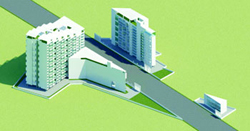 |
 |
Ar. Khan strongly feels that there is a big demand for housing in urban areas. He says, “We have limitations with traditional materials so we need to look at new materials like aluminium, fibre glass, nano materials and steel. At present, the most exciting material is the carbon fibre. It is a very energy efficient material. Glass has been a big building material right through the last century. But now, glass as a material has refined itself into much better and efficient product. I am personally keen on integrating technology with architecture as long as it does not cause harm to nature.”
Factors Affecting Architect’s Creative Ability
Fast construction, new generation materials, advanced technologies, lack of available space in cities are common factors associated with most urban projects. When questioned Ar. Khan whether these parameters limit in any way architect’s creative potential he says, “An architect cannot be subservient to anyone. If you want an architect to be creative, do not expect him to be subservient. An architect has to be a progenitor of new forms. So for that, nature gives him a big inspiration. Every architect has a responsibility of what to build, how to build and when to build and every builder or developer has a greater responsibility than architects because he is the one who hires the architect. The amalgamation of these two people is the formation of building. So, unless these two people have the right thought process, it is not possible to produce a right building.”
| Vision to initiate MIDAS The outlook of architectural education was changed with the initiation of MARG Institute of Design and Architecture Swarnabhoomi (MIDAS). Ar. Khan explains about the initiation of MIDAS, he says, “The institution was initiated in 2011. It was the vision of Mr. GRK Reddy - Founder, Chairman & Managing Director of MIDAS.We had a similar idea and started |
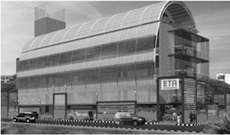 |
with this institution.At MIDAS, every project handled by the students is well thought off which is different from the traditional projects done in other schools of architecture.Our approach towards architecture is completely different. We make the students to understand the aspect of space. So, we give them a complicated project where they try to create the three dimensional imaginary volumes and it triggers their creative process. Now, we have to keep up the momentum because as when we set a benchmark, our responsibility increases and this makes us to produce something different.”He adds, “We have to look at things holistically and consider the present context of demand of the market and design the structures accordingly. So, the vision of MIDAS is to create an environment where freedom and spirit of expression will find a place to flourish not just with the students but the faculty who will have an immense opportunity to educate, research and experiment, thereby making MIDAS an outstanding institution. I want to make it a “Centre of Excellence” in learning architecture in South East Asia by 2020.”
Academia and Architecture
Ar. Khan thinks that as a teacher he has a greater responsibility and it is the most difficult job to do. He believes in the saying ‘Practice before you preach.’ He recalls his career as a teacher and says, “I started my career as a teacher in 1983 at Anna University. Later, I got an Aga Khan scholarship and went to do Masters in Architecture in England. I came back and started teaching in several universities. In the process, I realised that, I need to do something for the architectural fraternity with the creation of school for architecture and explain to the students what real architecture means.”
He is been inspired by the concept of Yantra. It is basically an instrument which is used for meditation. They are geometrical, mathematical and they talk about life in this universe. Yantra is all about universe, creativity of life, the philosophy and evolution and involution of life. He explains, “It says every life has a cycle and attains its peak. But on the other side, it has to descent, evolve into a new form or give birth to new ideas. Nature works in that way. One has to realise that he has to come back and give a new life and inspiration to that cycle. Teaching is all about that cycle. I have put in about 30 years of practice and now emerged as a full-fledged teacher cum practitioner. It is difficult to make the students to understand the basic forms of nature. I have about 250 students who are experimenting and discovering new things by understanding the whole idea of creativity.”
Learning - A Continuous Procedure Balancing the practice with academics clearly defines Ar. Khan’s way of looking at architecture as a subject. With the exposure to academics arena, Ar. Khan likes to experiment with new designs and ideas created by the students. He says, “As a teacher, I take academics seriously. I make sure that every project brief is prepared meticulously. For example, we recently had a project on ‘Infinite Space’. The idea was to play with planes and to create three dimensional volumes. The aim of it was transferring the ideas to their minds at the ground level. I consider this as a reverse process because, if I look at each and every project, that’s an education for me and that’s helping me in all my projects. Now, I am re-looking at things which help me to experiment and learn new things. It is important how you evolve with a project and explain the same to the students. The students with their creative ideas try to produce novel designs and come back with the profound results. So, that is educative for us. Every project rejuvenates me as a teacher.”
RIBA’s Association
Ar. Khan feels proud about the fact that he has been the member and fellow of various organisations, prominent being Royal Institute of British Architects (RIBA). He considers RIBA as the mother of all architectural institutes in the world. “There are about 50 members in India. There are few schools which are recognised like Centre for Environmental Planning & Technology (CEPT), Ahmadabad and School of Planning & Architecture (SPA) Delhi. It is an elite group of membership. RIBA validates international competition for young architects to participate and it boasts of World’s top architects giving lectures. Obviously, getting RIBA gold medal is an honour for an architect. I am thinking of MIDAS to be recognised by RIBA in a few years to come. This puts me in a world map and also gives me that network and connection to intellectually discuss about architecture. So, it is an honour to be a part of RIBA.”
With his future plans for the Garden City of Bangalore, Ar. Khan concludes with his thoughtful words. He says, “My vision for Bangalore is to have a huge architectural gallery. This gallery should give a platform to a multidisciplinary system for discussion among the children, citizens, architects, planners, developers and all others. With the right political will and citizen’s voices, we can do wonders. I hope this gallery happens in next 10 years. If we don’t plan it now for the future then it will never happen.”
EOM
Prof. Jaffer AA Khan, CEO – Jaff Design Studio, Bangalore
Director, MARG Institute of Design and Architecture Swarnabhoomi